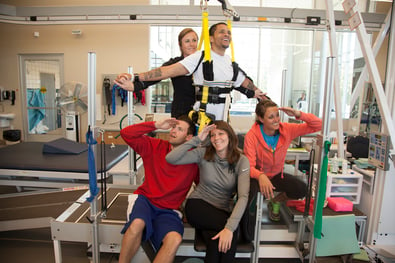NRN Spotlight: Craig Hospital - Blog - Reeve Foundation
It’s impossible to anticipate what life will bring. When a freak accident while horsing around with friends caused a C4 motor incomplete injury for avid CrossFit and Tough Mudder participant Sherown Campbell, his future changed in an instant.
“When I was first injured, it took a while for it to set in,” said Campbell, a 32-year-old husband and father of two young children. “I was very lucky that there was such a high caliber facility near where I live.”
Located in Englewood, CO, Craig Hospital is world-renowned as a premier rehabilitation and research hospital exclusively specializing in treating patients who have sustained spinal cord and traumatic brain injuries. The 93-bed, private, not-for-profit hospital joined the Reeve Foundation NeuroRecovery Network (NRN) in 2012, providing and developing activity-based therapies to promote functional recovery and improve the health and quality of life of people living with paralysis.
 “When Sherown enrolled in the NRN, he was dependent in most areas of self-care and needed maximum assistance to perform functional tasks,” said Meghan Joyce PT, DPT, who is the NRN Clinical Supervisor at Craig Hospital. “He was extremely weak and demonstrated significant spasticity (resistance to movement) throughout his whole body. He scored very low on all baseline outcome measures, as he was only really able to move his right arm to drive his power wheelchair.”
“When Sherown enrolled in the NRN, he was dependent in most areas of self-care and needed maximum assistance to perform functional tasks,” said Meghan Joyce PT, DPT, who is the NRN Clinical Supervisor at Craig Hospital. “He was extremely weak and demonstrated significant spasticity (resistance to movement) throughout his whole body. He scored very low on all baseline outcome measures, as he was only really able to move his right arm to drive his power wheelchair.”
After three months of intensive NRN Locomotor Training, Campbell was the first patient enrolled in the pilot NRN Upper Extremity Intervention therapy through Craig’s Occupational Therapy (OT) program. Upper Extremity Intervention utilizes neuromuscular electrical stimulation to the shoulder, forearm, hands, and trunk as its primary intervention to optimize function and recovery. First developed by Dr. Susan Harkema and her team at the Human Locomotion Research Center in Louisville, KY, the intervention it is now being disseminated through the NeuroRecovery Network to make the latest treatments available as widely and quickly as possible.
“Craig Hospital was an early adopter of expanding the NRN to include upper extremity intervention and has since had a strong influence in the development and formation of this program for the NRN,” said Joyce who stressed the importance of teamwork as part of the model for care. “The PT and the OT must work together collaboratively and creatively to help maximize recovery in the nervous system, meet the patient’s goals, and deliver the best outcome.”
As Campbell demonstrated improvement in his physical therapy goals, occupational therapy would incorporate his new level of function into their sessions to challenge him maximally, for example, practicing upper extremity activities while standing or walking.
“Sherown’s progress was incredible,” said Joyce. “He is a highly motivated individual and pushed himself throughout the program. Everything we gave him to work on outside of therapy, he did with great determination and enthusiasm.”
Campbell participated in outpatient therapy at Craig for a total of six months, receiving treatment five days a week for an hour and a half a day. All told, he participated in 120 Locomotor Training sessions and 60 OT sessions.
“I’m usually pretty hard on myself and pretty motivated,” said Campbell. “Getting to be part of the NRN program was exactly what I needed.”
Like many patients, Campbell also faced an additional hurdle to overcome—insurance. Individuals who have sustained spinal cord injuries require ongoing rehabilitation, often far beyond what most insurance companies therapy benefit allow. Providing intensity, repetition and task specific practice through standardized interventions is important for the patient’s success.
“Sherown, like so many others, had a limited insurance benefit which could have been a barrier to his outcome,” said Joyce. “However, advocating to Campbell’s insurance company, sharing his tremendous functional progress, and requesting additional sessions proved successful; he was allowed 70 more sessions, which worked to his benefit. We were grateful that the insurance company recognized the need for this intensive therapy. Rehabilitation is an ongoing need post-SCI, one that does not end in 24 visits alone.”
Now, almost two years since his injury and a year since his discharge from Craig, Campbell can walk unassisted and continues to improve his gait speed and endurance. Not surprisingly, he is already back doing adapted CrossFit training. He even climbed the Manitou Incline, a rigorous Colorado hiking trail that climbs 2,000 feet in less than a mile.
“Sherown is an amazing person, athlete and father,” said Joyce. “With his level of disability coming into the program, it is remarkable to see where he is now. I truly believe he wouldn’t have had the same outcome without his internal drive and dedication, the extension of his insurance benefits to provide the amount of therapy he needed, and the intensity and repetition that the NRN program can provide.”
The feeling is mutual.
“The NRN program offered an excellent starting point to get to where I am today,” said Campbell. “I definitely would not be where I am without the NRN. Even if I had gotten some mobility back, the repetition and the lessons learned from Meghan and others have been key to my success.”
“I’ve been pretty fortunate,” said Campbell. “The program was so beneficial to me and I am happy Craig Hospital and the other NRN sites can provide the opportunity for other patients to get started on their recovery. I hope the program will continue to expand and offer life-changing help to many more patients.”
Join Our Movement
What started as an idea has become a national movement. With your support, we can influence policy and inspire lasting change.
Become an Advocate